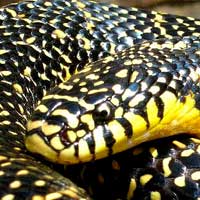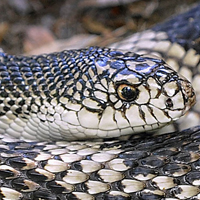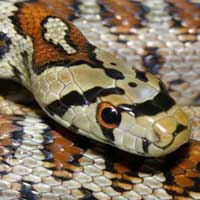Unveiling the Tiger Snake: A Comprehensive Guide to This Venomous Reptile
The Tiger Snake (Notechis scutatus) belongs to the Elapidae snake family, which includes venomous snakes equipped with fixed front fangs and potent neurotoxic venom.
Scientific Name: Notechis scutatus
Snake Family: Elapidae

An Overview of the Tiger Snake
The Tiger Snake (Notechis scutatus) is one of the most venomous snakes in the world, native to southern regions of Australia and Tasmania. Recognized for its striking banded appearance, resembling the stripes of a tiger, this snake is highly adaptable and inhabits a variety of environments, including wetlands, grasslands, and forests. The Tiger Snake’s venom is potent and can cause severe symptoms if untreated, making it a species to approach with caution. Despite its fearsome reputation, it plays a vital role in controlling pest populations and maintaining ecological balance in its natural habitat.
Where Does the Tiger Snake Live?
The Tiger Snake’s habitat preferences are diverse, reflecting its adaptability to different environmental conditions. Key habitat characteristics include:
- Geographic Range: Found primarily in southern Australia, including Tasmania, and some offshore islands.
- Preferred Environments: Wetlands, grasslands, woodlands, and coastal areas with dense vegetation.
- Climate: Thrives in temperate climates but is also found in cooler, moist regions.
The Tiger Snake often stays close to water sources such as rivers, swamps, and lagoons, where its prey is abundant. It is known to seek shelter in hollow logs, under rocks, or within dense vegetation to avoid predators and extreme weather. Below is a table summarizing its habitat preferences:
| Habitat Feature | Description |
|---|---|
| Geographic Range | Southern Australia, Tasmania |
| Preferred Terrain | Wetlands, grasslands, coastal areas |
| Climate | Temperate and moist |
What Does the Tiger Snake Eat?
The Tiger Snake is a carnivorous predator with a diet that highlights its role in maintaining ecological balance. Key dietary details include:
- Primary Prey: Frogs, which are abundant in the wetlands where this snake often resides.
- Occasional Prey: Small mammals, birds, reptiles, and fish.
- Hunting Strategy: Ambush predator that uses its excellent camouflage to remain hidden, striking swiftly to inject venom and immobilize prey.
The Tiger Snake’s diet helps control populations of pests and invasive species, benefiting its ecosystem. Its ability to adapt its diet based on prey availability ensures its survival in various habitats.
Understanding the Behavior of the Tiger Snake
The Tiger Snake is known for its unique behavior and temperament, which make it both fascinating and dangerous. Key traits include:
- Activity Patterns: Diurnal in cooler weather and crepuscular or nocturnal in warmer climates.
- Defensive Behavior: When threatened, it flattens its body and raises its head to appear larger, often hissing loudly as a warning.
- Social Behavior: Solitary, except during the mating season or when basking in shared sunny spots.
Although the Tiger Snake is not inherently aggressive, it will defend itself vigorously if cornered or provoked. Understanding its behavior is essential for safe coexistence in regions where this snake is found.
Health and Lifespan of the Tiger Snake
The Tiger Snake is a resilient species, but it faces several health challenges. Important details include:
- Lifespan: 10-15 years in the wild, with longer lifespans in captivity under proper care.
- Health Threats: Habitat destruction, climate change, and human activity pose significant risks to this species.
- Predators: Birds of prey, feral cats, and larger snakes are common threats, particularly to juveniles.
Conservation efforts focused on habitat preservation and public education about the ecological importance of this snake are vital for its survival.
How Does the Tiger Snake Reproduce?
The Tiger Snake’s reproductive habits ensure its population remains stable in its natural habitat. Key details include:
- Mating Season: Occurs during the warmer months of spring and early summer.
- Reproductive Method: Ovoviviparous, meaning females give birth to live young instead of laying eggs.
- Litter Size: Produces 10-40 offspring per litter, depending on the female’s size and health.
- Hatchling Behavior: Newborns are fully venomous and capable of hunting small prey immediately after birth.
Protecting breeding habitats is critical to ensuring the successful reproduction and survival of the Tiger Snake population.
Safety Guidelines for Handling the Tiger Snake
Handling the Tiger Snake requires expertise and extreme caution due to its potent venom. Key safety tips include:
- Use professional tools such as snake hooks and secure transport containers.
- Wear protective gloves and boots to minimize the risk of envenomation.
- Ensure enclosures replicate the snake’s natural habitat and are escape-proof.
- Keep antivenom readily available and have a detailed emergency response plan in place.
Only trained professionals should handle this species. Public awareness about its behavior and ecological role can help reduce fear and ensure safe coexistence.
Disclaimer
The information provided in this article is for educational purposes only. SnakeEstate strongly advises against handling or interacting with venomous snakes, such as the Tiger Snake, unless you are a trained and licensed professional. These snakes pose significant risks, and improper handling can result in serious injury or death. Always adhere to local regulations and prioritize safety when dealing with wildlife.








